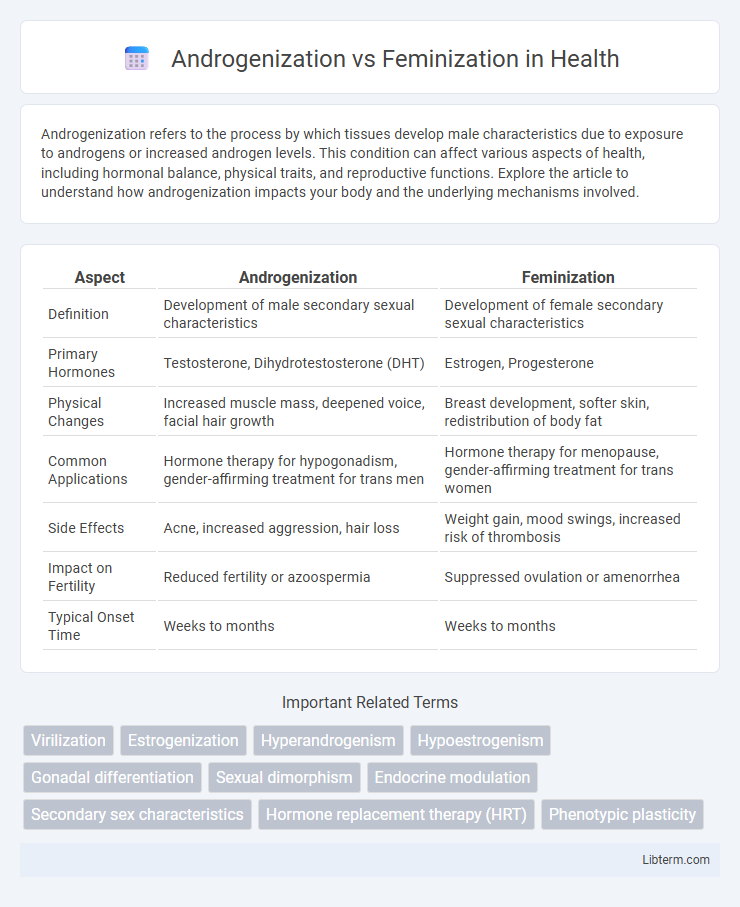Androgenization refers to the process by which tissues develop male characteristics due to exposure to androgens or increased androgen levels. This condition can affect various aspects of health, including hormonal balance, physical traits, and reproductive functions. Explore the article to understand how androgenization impacts your body and the underlying mechanisms involved.
Table of Comparison
| Aspect | Androgenization | Feminization |
|---|---|---|
| Definition | Development of male secondary sexual characteristics | Development of female secondary sexual characteristics |
| Primary Hormones | Testosterone, Dihydrotestosterone (DHT) | Estrogen, Progesterone |
| Physical Changes | Increased muscle mass, deepened voice, facial hair growth | Breast development, softer skin, redistribution of body fat |
| Common Applications | Hormone therapy for hypogonadism, gender-affirming treatment for trans men | Hormone therapy for menopause, gender-affirming treatment for trans women |
| Side Effects | Acne, increased aggression, hair loss | Weight gain, mood swings, increased risk of thrombosis |
| Impact on Fertility | Reduced fertility or azoospermia | Suppressed ovulation or amenorrhea |
| Typical Onset Time | Weeks to months | Weeks to months |
Understanding Androgenization and Feminization
Androgenization refers to the process by which male characteristics develop, primarily driven by the hormone testosterone influencing traits such as increased muscle mass, facial hair growth, and voice deepening. Feminization involves the development of female secondary sexual characteristics, often induced by estrogen and progesterone, leading to breast development, redistribution of body fat, and softer skin texture. Understanding these processes is crucial in hormone replacement therapy, gender-affirming treatments, and diagnosing endocrine disorders associated with hormonal imbalances.
Biological Mechanisms of Androgenization
Androgenization involves the activation of androgen receptors by testosterone and dihydrotestosterone, leading to the development of male secondary sexual characteristics through gene transcription modulation. This biological mechanism influences tissues such as the skin, hair follicles, and muscles, promoting traits like facial hair growth and increased muscle mass. The process is regulated by enzymes like 5-alpha reductase, which converts testosterone to the more potent dihydrotestosterone, amplifying androgenic effects on target cells.
Biological Mechanisms of Feminization
Feminization primarily involves the influence of estrogens and the suppression of androgens, which regulate secondary sexual characteristics by promoting breast development, fat redistribution, and skin softening. Estrogens act on estrogen receptors to modulate gene expression, leading to changes in the hypothalamic-pituitary-gonadal axis that reduce luteinizing hormone secretion and subsequently lower testosterone production. Aromatase enzymes convert androgens to estrogens, further amplifying feminizing biological effects through targeted cellular pathways in tissues such as adipose, skin, and the reproductive system.
Hormonal Influences on Gender Traits
Androgenization primarily involves the increase of androgens such as testosterone, which promotes the development of masculine traits including increased muscle mass, facial hair growth, and deeper voice. Feminization is driven by estrogens and progesterone, hormones that encourage the development of female secondary sexual characteristics like breast growth, redistribution of body fat, and softer skin texture. Hormonal influences on gender traits directly affect both physical appearance and behavioral patterns through the regulation of gene expression and neuroendocrine pathways.
Genetic Determinants of Sex Characteristics
Androgenization and feminization are processes influenced by genetic determinants that regulate sex characteristics through the interaction of specific genes and hormone pathways, particularly the SRY gene on the Y chromosome which triggers male differentiation. Variants in genes such as AR (androgen receptor) or mutations affecting estrogen receptor pathways can modulate responses to sex steroids, resulting in varying degrees of androgenization or feminization. The balance of androgen and estrogen signaling driven by genetic factors plays a critical role in the development of primary and secondary sex characteristics during embryogenesis and puberty.
Physical Manifestations: Androgenic vs Feminine Features
Androgenization leads to the development of male secondary sexual characteristics, including increased facial and body hair, deepening of the voice, and enhanced muscle mass due to elevated androgen levels. Feminization, influenced by estrogens and reduced androgens, promotes the growth of features such as breast development, softer skin, redistribution of body fat to hips and thighs, and a higher-pitched voice. These physical manifestations distinctly reflect the underlying hormonal milieu driving androgenic versus feminine phenotypic traits.
Psychological and Behavioral Impacts
Androgenization often leads to increased assertiveness, reduced anxiety, and heightened spatial abilities due to elevated testosterone levels influencing brain regions linked to aggression and risk-taking behaviors. Feminization is associated with enhanced empathy, social bonding, and verbal communication, reflecting the psychological effects of estrogen on neurotransmitters governing mood and social cognition. Both hormonal processes significantly shape personality traits and behavioral patterns through neuroendocrine modulation.
Medical and Therapeutic Interventions
Androgenization involves the administration of testosterone or other androgens to induce male secondary sexual characteristics, commonly used in hormone replacement therapy for transgender men and certain medical conditions like delayed puberty. Feminization therapies typically include estrogen and anti-androgens to promote female secondary sexual characteristics and suppress masculinizing hormones, often prescribed for transgender women and patients with hormone-sensitive conditions. Both interventions require careful monitoring of hormone levels, liver function, and cardiovascular health to minimize risks and ensure therapeutic efficacy.
Social and Cultural Perceptions
Androgenization often correlates with societal perceptions of strength, dominance, and traditional masculinity, while feminization is frequently linked to traits such as empathy, nurturing, and softness. Cultural norms heavily influence the acceptance and expression of these characteristics, shaping gender roles and expectations in different communities. These perceptions impact individual identity formation and social interactions, reinforcing or challenging binary gender constructs.
Androgenization and Feminization in Gender Diversity
Androgenization involves the increase of male hormones, particularly testosterone, leading to the development of masculine secondary sexual characteristics such as facial hair and a deeper voice, which is crucial in affirming gender identity for transgender men and non-binary individuals seeking masculinity. Feminization, on the other hand, entails the administration of estrogen and anti-androgens to promote the development of female secondary sexual characteristics like breast growth and softer skin, essential for transgender women and non-binary individuals aligned with femininity. Both processes are key components in gender-affirming hormone therapy, supporting psychological well-being and social transition by aligning physical traits with gender identity.
Androgenization Infographic

 libterm.com
libterm.com